"After graduating from the Rietvelt Art Academy in Amsterdam, I started out in experimental theatre, creating sets on location as well as performing. In 1993, I founded De Drie Gezusters with my sisters catering to (inter)national film crews on location from a converted truck. Eight years ago, my love for photography made me enter the Photo Academy. The book and series titled Resonance was part of my graduation in 2016. In these photographs my fascination with light and luminance finds its expression. The Memory of Time is a study about the plasticity of time and light, to see time and light as something elastic. For me there is a strong correlation between the impermanence of light and the fluidity of time."
"In The Memory of Time I explore abstract spaces. What interests me most, are architectural structures where light can fleet in and out, creating a new space. To me light is both a tangible and evanescent medium, if not a language. By fading, molding and carving the light in my photographs, I transform reality and move into an imaginative and intuitive realm. The process involves composing layered images that nearly look like drawings, scraping off the innate realism that is part of photography, thus creating a more sensorial and subliminal world."
Winner Single Image 9th Julia Margaret Cameron Award 2016, Category Architecture.
Works from the series Resonance received several Honorable Mentions: Tokyo International Foto Awards 2016 (2x), The Monochrome Awards 2016 (4x), The Monovision Photography Awards 2017 (6x), IPA 2017 (2x), IPA 2018 One Shot Harmony (1x).
The series Resonance was exhibited at The Indian Photography Festival 2016.
The book Resonance was exhibited at: Scan Photobooks (Spain), The Griffin Museum (USA), RPSP (UK), Tripp Gallery (UK), Unveil'd (UK).
Publication in the NEW2017, 100 Best Emerging Dutch Photographers of the year 2017.
